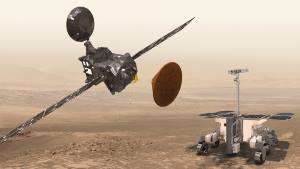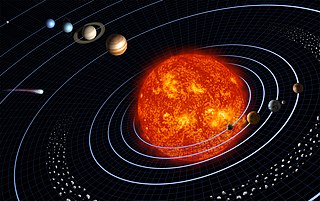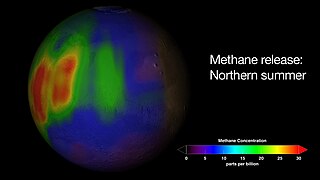Related Research Articles

Mariner 9 was a robotic spacecraft that contributed greatly to the exploration of Mars and was part of the NASA Mariner program. Mariner 9 was launched toward Mars on May 30, 1971, from LC-36B at Cape Canaveral Air Force Station, Florida, and reached the planet on November 14 of the same year, becoming the first spacecraft to orbit another planet – only narrowly beating the Soviet probes Mars 2 and Mars 3, which both arrived at Mars only weeks later.

Envisat is a large Earth-observing satellite which has been inactive since 2012. It is still in orbit and considered space debris. Operated by the European Space Agency (ESA), it was the world's largest civilian Earth observation satellite.

Mars Express is a space exploration mission being conducted by the European Space Agency (ESA). The Mars Express mission is exploring the planet Mars, and is the first planetary mission attempted by the agency. "Express" originally referred to the speed and efficiency with which the spacecraft was designed and built. However, "Express" also describes the spacecraft's relatively short interplanetary voyage, a result of being launched when the orbits of Earth and Mars brought them closer than they had been in about 60,000 years.

ExoMars is an astrobiology programme of the European Space Agency (ESA) and the Russian space agency (Roscosmos).

The atmosphere of Mars is the layer of gases surrounding Mars. It is primarily composed of carbon dioxide (95%), molecular nitrogen (2.8%), and argon (2%). It also contains trace levels of water vapor, oxygen, carbon monoxide, hydrogen, and noble gases. The atmosphere of Mars is much thinner than Earth's. The average surface pressure is only about 610 pascals (0.088 psi) which is less than 1% of the Earth's value. The currently thin Martian atmosphere prohibits the existence of liquid water on the surface of Mars, but many studies suggest that the Martian atmosphere was much thicker in the past. The higher density during spring and fall is reduced by 25% during the winter when carbon dioxide partly freezes at the pole caps. The highest atmospheric density on Mars is equal to the density found 35 km (22 mi) above the Earth's surface and is ≈0.020 kg/m3. The atmosphere of Mars has been losing mass to space since the planet's core slowed down, and the leakage of gases still continues today. The atmosphere of Mars is colder than Earth's. Owing to the larger distance from the Sun, Mars receives less solar energy and has a lower effective temperature, which is about 210 K. The average surface emission temperature of Mars is just 215 K, which is comparable to inland Antarctica. Although Mars' atmosphere consists primarily of carbon dioxide, the greenhouse effect in the Martian atmosphere is much weaker than Earth's: 5 °C (9.0 °F) on Mars, versus 33 °C (59 °F) on Earth. This is because the total atmosphere is so thin that the partial pressure of carbon dioxide is very weak, leading to less warming. The daily range of temperature in the lower atmosphere is huge due to the low thermal inertia; it can range from −75 °C (−103 °F) to near 0 °C (32 °F) near the surface in some regions. The temperature of the upper part of the Martian atmosphere is also significantly lower than Earth's because of the absence of stratospheric ozone and the radiative cooling effect of carbon dioxide at higher altitudes.

The Planetary Fourier Spectrometer (PFS) is an infrared spectrometer built by the Istituto Nazionale di Astrofisica along with the Istituto di Fisica dello spazio Interplanetario and the Consiglio Nazionale delle Ricerche. The instrument is currently used by the European Space Agency on both the Mars Express Mission and the Venus Express Mission. It consists of four units which together weigh around 31.4 kg, including a pointing device, a power supply, a control unit, and an interferometer with electronics.

Venera-D is a proposed Russian space mission to Venus that would include an orbiter and a lander to be launched in 2029. The orbiter's prime objective is to perform observations with the use of a radar. The lander, based on the Venera design, would be capable of operating for a long duration on the planet's surface. The "D" in Venera-D stands for "dolgozhivuschaya," which means "long lasting" in Russian.

The climate of Mars has been a topic of scientific curiosity for centuries, in part because it is the only terrestrial planet whose surface can be easily directly observed in detail from the Earth with help from a telescope.

The study of extraterrestrial atmospheres is an active field of research, both as an aspect of astronomy and to gain insight into Earth's atmosphere. In addition to Earth, many of the other astronomical objects in the Solar System have atmospheres. These include all the gas giants, as well as Mars, Venus and Titan. Several moons and other bodies also have atmospheres, as do comets and the Sun. There is evidence that extrasolar planets can have an atmosphere. Comparisons of these atmospheres to one another and to Earth's atmosphere broaden our basic understanding of atmospheric processes such as the greenhouse effect, aerosol and cloud physics, and atmospheric chemistry and dynamics.

The ExoMars Trace Gas Orbiter is a collaborative project between the European Space Agency (ESA) and the Russian Roscosmos agency that sent an atmospheric research orbiter and the Schiaparelli demonstration lander to Mars in 2016 as part of the European-led ExoMars programme.

MAVEN is a NASA spacecraft orbiting Mars to study the loss of that planet's atmospheric gases to space, providing insight into the history of the planet's climate and water. The name is an acronym for "Mars Atmosphere and Volatile Evolution" while the word maven also denotes "a person who has special knowledge or experience; an expert". MAVEN was launched on an Atlas V rocket from Cape Canaveral Air Force Station, Florida, on 18 November 2013 UTC and went into orbit around Mars on 22 September 2014 UTC. The mission is the first by NASA to study the Mars atmosphere. The probe is analyzing the planet's upper atmosphere and ionosphere to examine how and at what rate the solar wind is stripping away volatile compounds.
Paul O. Wennberg is the R. Stanton Avery Professor of Atmospheric Chemistry and Environmental Science and Engineering at the California Institute of Technology (Caltech). He is the director of the Ronald and Maxine Linde Center for Global Environmental Science. He is chair of the Total Carbon Column Observing Network and a founding member of the Orbiting Carbon Observatory project, which created NASA's first spacecraft for analysis of carbon dioxide in the atmosphere. He is also the principal investigator for the Mars Atmospheric Trace Molecule Occultation Spectrometer (MATMOS) to investigate trace gases in Mars's atmosphere.

ADEOS I was an Earth observation satellite launched by NASDA in 1996. The mission's Japanese name, Midori means "green". The mission ended in July 1997 after the satellite sustained structural damage to the solar panel. Its successor, ADEOS II, was launched in 2002. Like the first mission, it ended after less than a year, also following solar panel malfunctions.
Rosalind Franklin, previously known as the ExoMars rover, is a planned robotic Mars rover, part of the international ExoMars programme led by the European Space Agency and the Russian Roscosmos State Corporation. The mission was scheduled to launch in July 2020, but was postponed to 2022. The 2022 Russian invasion of Ukraine has caused an indefinite delay of the programme, as the member states of the ESA voted to suspend the joint mission with Russia; in July 2022, ESA terminated its cooperation on the project with Russia. As of May 2022, the launch of the rover is not expected to occur before 2028 due to the need for a new non-Russian landing platform.

Schiaparelli EDM was a failed Entry, Descent, and Landing Demonstrator Module (EDM) of the ExoMars programme—a joint mission of the European Space Agency (ESA) and the Russian Space Agency Roscosmos. It was built in Italy and was intended to test technology for future soft landings on the surface of Mars. It also had a limited but focused science payload that would have measured atmospheric electricity on Mars and local meteorological conditions.
The Atmospheric Chemistry Suite (ACS) is a science payload consisting of three infrared spectrometer channels aboard the ExoMars Trace Gas Orbiter (TGO) orbiting Mars since October 2016. The three channels are: the near-infrared channel (NIR), the mid-infrared channel (MIR), and the far infrared channel.
Infrared Spectrometer for ExoMars (ISEM) is an infrared spectrometer for remote sensing that is part of the science payload on board the European Space Agency'sRosalind Franklin rover, tasked to search for biosignatures and biomarkers on Mars. The rover is planned to be launched in August–October 2022 and land on Mars in spring 2023.
ADRON-RM is a neutron spectrometer to search for subsurface water ice and hydrated minerals. This analyser is part of the science payload on board the European Space Agency'sRosalind Franklin rover, tasked to search for biosignatures and biomarkers on Mars. The rover is planned to be launched in August–October 2022 and land on Mars in spring 2023.
The Fine-Resolution Epithermal Neutron Detector (FREND) is a neutron detector that is part of the instrument payload on board the Trace Gas Orbiter (TGO), launched to Mars in March 2016. This instrument is currently mapping hydrogen levels to a maximum depth of 1 m beneath the Martian surface, thus revealing shallow water ice distribution. This instrument has an improved resolution of 7.5 times over the one Russia contributed to NASA's 2001 Mars Odyssey orbiter.

The reported presence of methane in the atmosphere of Mars is of interest to many geologists and astrobiologists, as methane may indicate the presence of microbial life on Mars, or a geochemical process such as volcanism or hydrothermal activity.
References
- ↑ "ExoMars Trace Gas Orbiter and Schiaparelli Mission (2016)". European Space Agency. 16 October 2016. Retrieved 24 October 2016.
- ↑ Allen, Mark A.; Witasse, Olivier (2011). 2016 ESA/NASA ExoMARS/Trace Gas Orbiter. Mars Exploration Program Assessment Group. 15–16 June 2011. Lisbon, Portugal. hdl:2014/42148.
- 1 2 Mitschdoerfer, Pia; et al. (9 April 2018). "ExoMars poised to start science mission". European Space Agency. Retrieved 18 June 2018.
- ↑ Neefs, Eddy; et al. (2015). "NOMAD spectrometer on the ExoMars trace gas orbiter mission: Part 1—design, manufacturing and testing of the infrared channels". Applied Optics. 54 (28): 8494–8920. Bibcode:2015ApOpt..54.8494N. doi:10.1364/AO.54.008494. hdl: 2268/228584 . PMID 26479628.
- 1 2 ExoMars NOMAD instrument. Belgian Institute for Space Aeronomy. Accessed: 13 August 2018.
- 1 2 3 ExoMars Trace Gas Orbiter Instruments - NOMAD. European Space Agency. 4 November 2016. Accessed: 13 August 2018.
- ↑ Thomas, I. R.; Vandaele, A. C.; Neefs, E.; et al. (2017). "The NOMAD Spectrometer Suite on the ExoMars 2016 Orbiter: Current Status" (PDF). The Sixth International Workshop on the Mars Atmosphere: Modelling and Observation. 17-20 January 2017. Granada, Spain.: 4401. Bibcode:2017mamo.conf.4401T.
- 1 2 3 4 5 6 7 The NOMAD Spectrometer Suite for Nadir and Solar Occultation on the ExoMars Trace Gas Orbiter. (PDF) M. R. Patel, A.C. Vandaele, F. Daerden, R. Drummond, E. Neefs, J.-J. López-Moreno, J. Rodriguez Gomez, G. Bellucci, and the NOMAD team. 2014
- ↑ Robert, S.; et al. (2016). "Expected performances of the NOMAD/ExoMars instrument". Planetary and Space Science. 124: 94–104. Bibcode:2016P&SS..124...94R. doi: 10.1016/j.pss.2016.03.003 . S2CID 34308236.
{{cite journal}}: CS1 maint: multiple names: authors list (link) - 1 2 Patel, Manish R.; et al. (2017). "NOMAD spectrometer on the ExoMars trace gas orbiter mission: Part 2—design, manufacturing, and testing of the ultraviolet and visible channel". Applied Optics. 56 (10): 2771–2782. Bibcode:2017ApOpt..56.2771P. doi:10.1364/AO.56.002771. hdl: 10261/149007 . PMID 28375240.
- ↑ Nadir and Occultation for Mars Discovery (NOMAD). NASA Space Science Data Coordinated Archive. Accessed: 18 August 2018.
